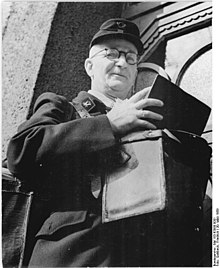message
In everyday language, a message describes the content of information . The notification of a message is the notification. In information theory , a message is information that can be described quantitatively as a signal and qualitatively as a meaningful sign or sequence of characters. In the process of communication, it is transmitted from a sender to a recipient according to a code . It is newsworthy for the recipient and evokes an interpretive response in addition to the stimulation .
Messages are the basic element of communication and thus subject of consideration by various sciences , including the semiotics , information theory, the Communications , the communications technology and behavioral research .
etymology

According to the German dictionary , the message is a "message to Darnachrichten". Message has stood for a message since around 1600. In the sixteenth to eighteenth centuries, news is evidence of instructions for something to be followed, which is gradually being suppressed. Since the 20th century, news (broadcast via radio, television) has been used to denote current, particularly political reports in the plural . The latest definition of news comes from Dietz Schwiesau and Josef Ohler: "The news is a direct, essential and as objective message as possible about a new event that is important and / or interesting for the public."
Semiotics and information theory
In semiotics , signs develop their meaning on the semantic level .
A message is generally transmitted by signals that, when understood, bring knowledge to the recipient . It is crucial that the recipient is able to decrypt the message, i.e. that the coding (language, data format, etc.) of the message is known and that a semantic context is available so that the meaning of the message can be understood can. In this sense, a message is information in the state of transmission. If information is also transmitted that helps to decode the content of the message or message, it is referred to as a meta message .
Communication and data technology
The technical transmission or transmission is the task of communication technology . In network technology , a message is understood to be a data packet .
Media and everyday language
News is often synonymous with news and information about events . In common parlance, the plural news stands for reports on current events in the mass media , such as television , radio or newspapers and magazines . There is a distinction between "good news", such as the rescue or recovery of people and "bad news" as reports of disasters , deaths or accidents .
In Christian religions , “Good News” or “Good News” is synonymous with the gospel accounts of the Bible about the life and work of Jesus of Nazareth .
See also
- Information content
- Message exchange / message passing
- Newsworthiness
- Unified Messaging (types of messages)
- Four-sided model (also 4-ear model)
literature
- Ines Bose / Dietz Schwiesau (eds.): Write, speak, listen to messages. Research into the intelligibility of radio news. Berlin 2011, ISBN 978-3-86596-990-3 .
- Schwiesau, Dietz / Ohler Josef: News - classic and multimedia. A Manual for Education and Practice. Springer VS. Wiesbaden 2016 http://www.gelbe-reihe.de/nachricht/
Web links
Individual evidence
-
↑
"MESSAGE, f. only since the 17th century.
- notification of the news and the night afterwards ....
- general notification of an incident etc. ”.
- Jacob and Wilhelm Grimm: German Dictionary . Volume 7. Leipzig 1889, p. 103
- ^ Etymological dictionary of German according to Pfeifer, online at DWDS , accessed on November 29, 2011
